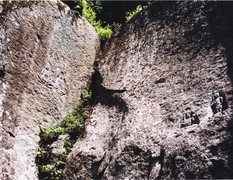Bulletin of the Geological Survey of Japan Top Page
Bulletin of the Geological Survey of Japan Vol.54 No.11/12 (2003)
Cover photograph | Table of Contents | Abstract
Cover photograph

Buddhist relief sculpture on the Abukuma granite
Buddhist relief sculpture (1709) in Katsurao village, Fukushima prefecture, Japan, is engraved on the Abukuma granite, a famous building stone called "Mikage-ishi". The relief was donated by Shigetomo, a second generation of Matsumoto Sankuro family which has governed the village hundreds of years ago. The family constructed the big house called "Katsurao daijin" in the village, and was holding 100 or more employees. At present, the half of the residents in the Katsurao village has the family name of Matsumoto and has a relation with "Katsurao daijin".
(Atsushi Kamei)
Table of Contents
| Title | Author | |
|---|---|---|
| Article | ||
| Tephra beds of the Pliocene Dainenji Formation distributed in the Pacific side of Fukushima Prefecture, northeastern Japan. (part 1): Chronostratigraphy |
Yukio Yanagisawa, Tomohiro Takahashi, Yoshitaka Nagahashi, Takeyoshi Yoshida and Katsuki Kurokawa (351-364) | 54_11_01.pdf [1,259 KB] |
| Tephra beds of the Pliocene Dainenji Formation distributed in the Pacific side of Fukushima Prefecture, northeastern Japan. (part 2): Petrography |
Tomohiro Takahashi, Yoshitaka Nagahashi, Yukio Yanagisawa, Takeyoshi Yoshida and Katsuki Kurokawa (365-393) | 54_11_02.pdf [2,619 KB] |
| Geology and petrography of the Abukuma granites in the Hiyama district, Fukushima Prefecture, NE Japan. | Atsushi Kamei, Tetsuichi Takagi and Kazuya Kubo (395-409) | 54_11_03.pdf [940 KB] |
Abstract
Tephra beds of the Pliocene Dainenji Formation distributed in the Pacific side of Fukushima Prefecture, northeastern Japan.
(part 1): Chronostratigraphy
Yukio Yanagisawa, Tomohiro Takahashi, Yoshitaka Nagahashi, Takeyoshi Yoshida and Katsuki Kurokawa
Tephrostratigraphy is established for the Pliocene Dainenji Formation distributed in the middle part of the Pacific side area in Fukushima Prefecture. A workable high-resolution microfossil chronostratigraphy is also developed for the formation by integrating all available microfossil information on diatom, nannofossil, planktonic foraminiferal and radiolarian biostratigraphy. The age of each tephra bed in the Dainenji Formation can be estimated by correlation to the standard magneto-biostratigraphic time scale. This report and a companion study on petrography of tephra beds (Takahashi et al., 2003) provide a firm basis of the Pliocene tephrochronology in the southern Tohoku Province.
Tephra beds of the Pliocene Dainenji Formation distributed in the Pacific side of Fukushima Prefecture, northeastern Japan.
(part 2): Petrography
Tomohiro Takahashi, Yoshitaka Nagahashi, Yukio Yanagisawa, Takeyoshi Yoshida and Katsuki Kurokawa
Petrographical characteristics such as grain-size composition, mineral assemblages, heavy mineral assemblage, and shape of volcanic glass shards were systematically described for the 101 tephra beds (133 samples) intercalated in the Pliocene Dainenji Formation of the Sendai Group distributed in the Pacific side of Fukushima Prefecture, northeastern Japan. EDS chemical analysis of 1029 points of volcanic glass from 98 tephras (103 samples) was also performed, and the secular changes in petrological feature and chemical composition of glass shards (especially the amount of K2O) were clarified. Tephra beds of the Dainenji formation are mainly fine-grained glassy tephra (C-type glass subject), and usually contain hornblende phenoclasts. Chemical composition of glass shards is in the range of 68.8-80.0 wt.% SiO2. Tephras in the Dainenji Formation are divided into Low-K, Medium-K and High-K groups on the basis of K2O contents. At least two upward K2O decreases from Medium-K to Low-K are recognized, possibly reflecting the compositional zoning at the top of magma reservoir. Six tephra beds are clearly distinguished from other tephra by higher K2O contents and the presence of biotite phenoclasts, and might be widespread tephra beds derived from central Japan.
Geology and petrography of the Abukuma granites in the Hiyama district, Fukushima Prefecture, NE Japan.
Atsushi Kamei, Tetsuichi Takagi and Kazuya Kubo
Intermediate to felsic granitic rocks and gabbroic rocks are complexly distributed in the Hiyama district in the Abukuma granitic terrain, Fukushima Prefecture, NE Japan. The granitic rocks have been divided into older and younger types on the basis of petrographical and geological features. The older type is composed of foliated granodiorite to tonalite with euhedral to subhedral hornblende. In contrast, the younger type comprises massive granodiorite to granite with coarse-grained K-feldspar or minor muscovite. In this area, the older type is represented by Nagaya, Shikayama, and Ishimori bodies, and the younger type comprises Furumichi, Miharu, Katsurao, Gojyunin-yama, and Hatsumori bodies. The gabbroic rocks occur as small roof pendants within the granitic rocks. The plutonic bodies have different compositional trends each other on variation diagrams. The magnetic susceptibility of the granitic rocks generally corresponds to ilmenite-series granites.
On the basis of trace elements compositions, we examined the petrogenesis of Nagaya, Shikayama, Katsurao, and Gojyunin-yama bodies. The granitic magmas of Nagaya and Shikayama bodies are explained to have been formed by melting of a basaltic rock under the pressure of <1gpa with="" high="" i="">fH2O condition. On the other hand, Katsurao and Gojyunin-yama bodies have two possibilities for petrogenesis. One possibility is that the granitic magmas derived from melting of a basaltic rock under the pressure of <1gpa with="" low="" i="">fH2O condition, another one is that the magmas were significantly controlled by fractionation of plagioclase.
Geological Survey of Japan, AIST
- About GSJ
- Our Activities
- Purchase guide
-
Publications and Database
- information
- Bulletin of the Geological Survey of Japan
- bull2025(Vol.76)
- bull2024(Vol.75)
- bull2023(Vol.74)
- bull2022(Vol.73)
- bull2021(Vol.72)
- bull2020(Vol.71)
- bull2019(Vol.70)
- bull2018(Vol.69)
- bull2017(Vol.68)
- bull2016(Vol.67)
- bull2015(Vol.66)
- bull2014(Vol.65)
- bull2013(Vol.64)
- bull2012(Vol.63)
- bull2011(Vol.62)
- bull2010(Vol.61)
- bull2009(Vol.60)
- bull2008(Vol.59)
- bull2007(Vol.58)
- bull2006(Vol.57)
- bull2005(Vol.56)
- bull2004(Vol.55)
- bull2003(Vol.54)
- bull2002(Vol.53)
- bull2001(Vol.52)
- Bulletin of the Geological Survey of Japan(old)
- Annual Report on Active Fault and Paleoearthquake Researches
- Reports, Geological Survey of Japan
- CCOP-GSJ Groundwater Project Report
- CCOP Technical Bulletin
- Cruise Report
- Geological Hazards
- Learning and Education
- GSJ Database Collection
- Collection of links

